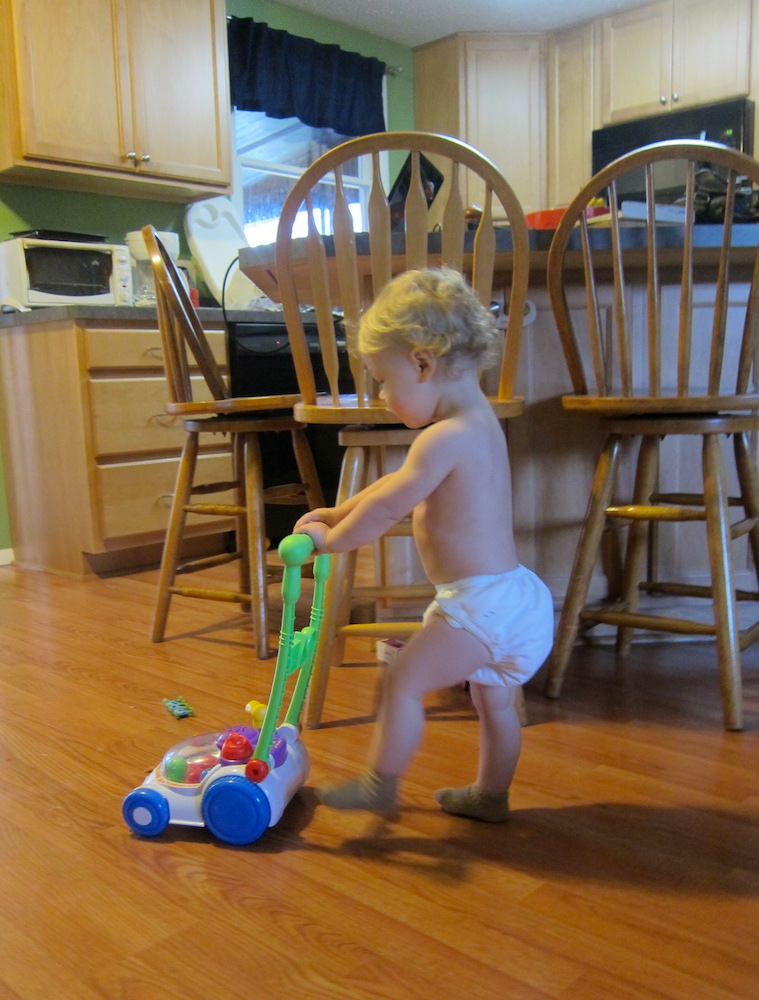
Howdy! While Mr. Frugalwoods and I enjoy/attempt to survive our first few months as parents to our daughter, Babywoods, I have a delightful slate of guest posts from my friends lined up for your reading pleasure. Today, please welcome the delightful Kalie from Pretend to Be Poor!
By: Kalie
I still can’t fathom how methods of containing baby excrement became so controversial and polarizing. Rather than defining myself according to the logistical minutia of baby care, I decided to select the best of all camps, based on our family’s needs in different settings.
But I wanted to do this parenting thing frugally, which inevitably launched me back into the fray of my search results. Turns out there exist about 1,467 styles of cloth diapers, and not having been in nappies for quite some time myself, how was I to decipher which type makes the best B.M. barrier? There were pockets, prefolds, flats, all-in-ones, diaper covers, inserts, liners, fasteners… and the list continued. I nervously checked my countdown till due date and commenced research.
Here I’ve streamlined the information, coupled it with my four years of experience, and divorced it from the debate, judgment, jargon, and advertising that clutter other content. I’ve saved over $1,300 by using cloth diapers (hello, college fund!), and I’ve also appreciated the convenience of disposables at times. I don’t draw lines over diaper decisions. But since dealing with the derrière is a potentially expensive facet of family life, here are the dirty details of comparative diaper costs.
Is Cloth Really Cheaper?
A mythology circulates, even amongst some frugal folk, that cloth diapers aren’t less expensive than disposables. After all, the initial investment for cloth can reach as high as $500, and there’s the hidden cost of reviving dirties via laundry. Yet my calculations confirm that if cloth diapers aren’t saving you money, you’re doing them wrong.
Like just about anything, there are multiple price points for cloth diapers. Let’s break it down with a cost-comparison table. But first, my assumptions: we’re all frugal people here, so I’m citing competitive prices. You certainly could pay more for any of these options, but you won’t need to after you apply the discounted diaper acquisition pointers below.
I won’t overwhelm you with the number of diaper changes you’ll perform before potty-training, but I’ve assumed an average of eight disposable diapers per day (it’ll be more at first). I figure for 24 cloth diapers since this is the quantity I recommend purchasing for full-time cloth use.
| Diaper Type | Description | Price Per Diaper | Price Over 2 Years | Savings Over 2 years vs. Store Brand Disposables |
| Disposable, Name Brand | $0.25 | $1,460 | -$584 | |
| Disposable, Store Brand | $0.15 | $876 | ||
| Old-fashioned Cloth
(also called flats or prefolds)
Price includes 24 diapers, 3 rubber fasteners, and 8 covers |
A rectangle that’s secured with a reusable rubber fastener or safety pins. Covers serve as a moisture barrier. | $2.92 | $70 | $806 |
| Cloth, Pocket or
All-in-one, Full Price
Price for pocket includes 2 inserts |
Shaped like a disposable diaper, with built-in fasteners & cover. Pocket diapers have an opening for one or more absorbent inserts; these are built into all-in-ones. | $18 | $432 | $444 |
| Cloth, Pocket, Discounted
Price includes 2 inserts |
Same as above. | $7 | $168 | $708 |
The upfront cost of cloth diapers appears daunting next to disposables. Just how long does it take to get a return on your investment? Because laundry costs are so variable I exclude them in the following table, but I address this expense below in detail.
Return on Investment Time
| Name Brand Disposables |
Store Brand Disposables
|
|
| Old-fashioned Style | Less than 2 months | 2 months
|
| Name Brand Pocket or All-in-One | 7 months | 12 months
|
| Discounted Pocket or All-in-One | 3 months | 5 months
|
Frugal & Flexible
The obvious extreme-frugality choice are the old-fashioned cloth diapers, the type your grandmother or mother may have used. These must be folded, secured with a fastener, and sheathed with a cover. Despite being a no-brainer from a financial standpoint, they’ve declined in popularity due to being less user-friendly.
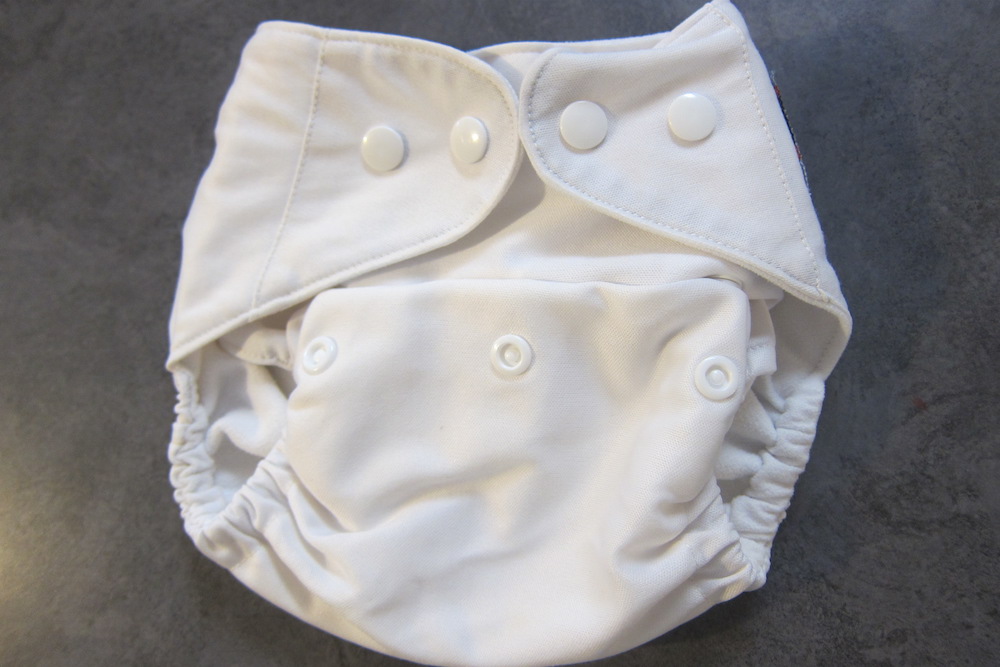
I’m abysmally unskilled at all things crafty, so as soon I spotted the phrase “origami fold” alongside this option, I was out. Now I realize I was over-reacting. After all, people of all crafting abilities have used flat pieces of cloth to diaper their babies for millennia.
For me, discounted pocket diapers offered the perfect balance of frugality and ease-of-use. They were convenient for grandparents, babysitters, and my husband (though I’m certain they could all out-origami me any day). I spent $110 on cloth pocket diapers, making my ROI time only three months.
My hybrid approach entailed: disposable diapers for the first six weeks of newborn chaos, replaced by cloth for day and a disposable at night. After 18 months I was pregnant again, gagging as I scraped toddler feces into the toilet, and had enough of carting around dirty diapers and changing my son twice as often as his disposable-wearing comrades. So I switched to disposables, hoped he’d potty train soon (it was another year), and stored the cloth nappies for Baby #2. They gave an additional six months’ service before the inserts bit the dust and I returned to disposables.
I share my experience not to recommend any particular approach (or gross anyone out), but to highlight the benefits of adopting a flexible yet frugal stance for diapering. My hybrid was not optimally thrifty, but I saved a considerable sum while maintaining the freedom to make changes as our family grew. Sometimes as parents we need to balance our ideals with our sanity.
What About Laundry Costs?
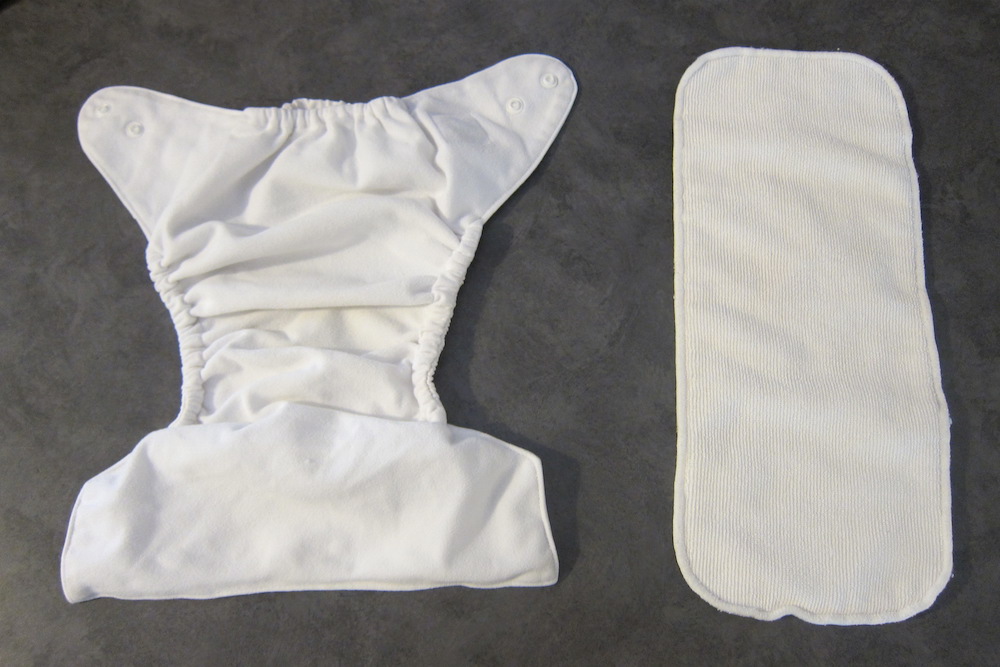
The myth of a dismal return on investment for cloth diapers centers largely on the water and energy used to wash them. The short answer is: laundry costs won’t ruin your cloth diaper savings. The long answer is: if you wash in cold with homemade detergent and line-dry, you’ll pay around 25 cents per load. With 24 diapers you’ll wash a load about every other day (be sure to leave yourself some diapers to use while they’re drying). Line-drying is recommended for reducing wear and tear, and for the sun’s sanitizing and bleaching effects.
But say you’re like me, sleep-deprived and behind on laundry, and wash with store-bought soap and run the dryer. This costs about 60 cents. Even at your laziest, least frugal moments, the cost to wash (and reuse) 24 diapers is equal to buying 4 disposables. You can calculate your laundry costs using this calculator.
A diaper service, on the other hand, can ruin cloth savings. BabyCenter estimates you’ll pay more than $50 per month for this dirty job. When using full-time disposables, I’ve spent no more than $35 per month on diapers.
Discounted Cloth Diaper Acquisition Tips
Old-fashioned diapers are so inexpensive that they can be purchased just about anywhere. Simple plastic covers are the thriftiest option, followed by discounted wrap-style covers or pocket diaper covers (without inserts).
Buying name-brand pocket or all-in-one cloth diapers is a big investment, especially if you’re a new parent who’s not sure if you’ll like using them. Purchase one to trial before dropping $500 on diapers. But there are many less expensive ways to procure cloth diapers. An increasing number of lower-cost brands are available on Amazon, Ebay, and other domestic and international web sites.
Other sources to check include forums like DiaperSwappers.com, local second-hand stores, Facebook Buy/Sell/Trade pages, Craigslist, or online parenting forums. You’ll find both new and used nappies for sale. Before you wretch at the thought of buying pre-pooped diapers—read the listing. Parents sometimes purchase cloth diapers only to find they are not the right fit for their family. Checking the description may reveal that the pre-owned diapers are in pristine condition.
Those more crafty than me may wish to sew their own. Diapers are not a terribly complicated shape and fabrics like cotton, microfiber, and fleece can create inexpensive custom diapers.
What If I Don’t Want to Wash Baby Poop?
Then don’t! No parent can escape all contact with human waste. However, cloth diapering is not for everyone, and if you’re not sold on it, it isn’t economical to waste money on cloth diapers you won’t use. Or you may have a day care or shared laundry situation that isn’t conducive to cloth. If you plan to use any disposables, I highly recommend signing up for Amazon Mom to get 20% off already-competitive diaper prices. Amazon Mom is free for a trial period. The service remains free for up to a year if you spend $25 per month in the baby department. You’ll spend this without trying if you have a diaper subscription (please be sure to read the fine print when signing up).
To get the best diaper prices, find the type you want. Check for “coupons” to clip on the product page. Then use the Subscribe & Save option on the right side of the screen:
Shipping is free and diapers will automatically be delivered to your doorstep. You can cancel or change the frequency at any time before the order ships (you’ll be notified ahead of time by email). Plan ahead a couple weeks, as the shipping schedule is monthly and two-day shipping does not apply. And remember to change sizes as your baby grows.
My favorite aspect of Amazon Mom is that it sets my shopping on frugal autopilot, meaning no last-minute diaper runs to retailers where I’m tempted to browse for stuff I don’t need on my way to the baby aisle. So I save on diapers and gas while reducing unwelcome outings and impulse buys. Quadruple win!
More Discounted Disposable Acquisition Tips
Diaper raffle: A friend of mine was fully stocked for her baby’s first year through a diaper raffle. If you’re having a baby shower or sprinkle (for subsequent children), consider requesting a diaper raffle. Any guest who brings a package of disposable diapers is entered to win a prize, such as a $25 gift card. Your shower host may be willing to provide the gift card, but even if you purchase it, you’re sure to receive more than $25 worth of diapers.
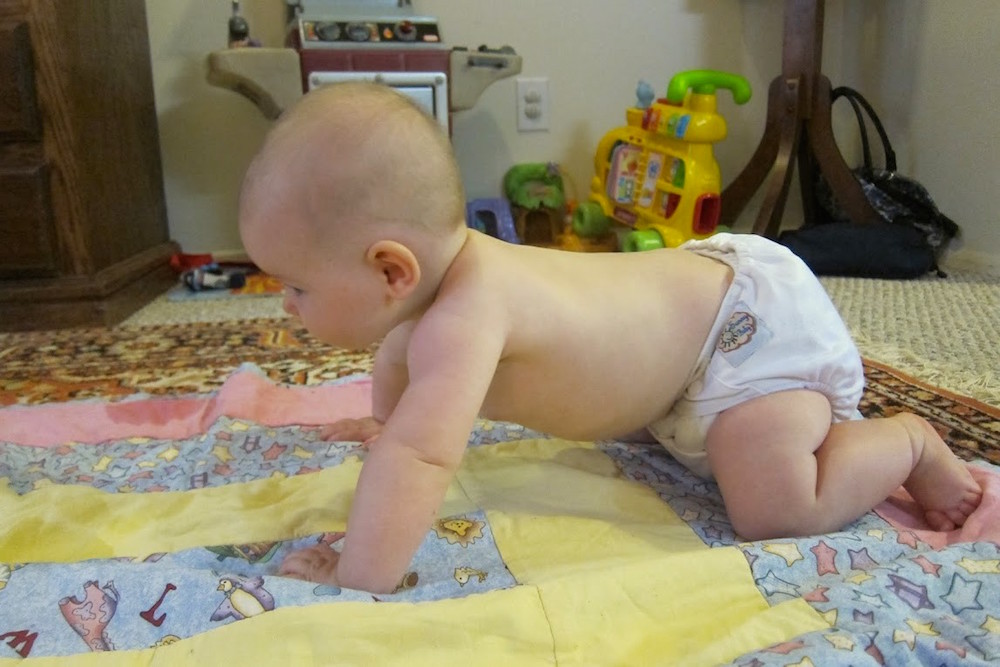
Hospital diapers: The hospital will supply your baby with diapers during your stay. Any left in the hospital bassinet drawers are yours to keep.
Discontinued diapers: Check stores that sell close-outs for discontinued diapers. Occasionally the big brands change minor design details such as the characters printed on the diapers, and older styles are sold cheaply at close-out retailers.
Second-hand stores: Children’s resale shops often sell disposable diapers. When children outgrow a size or become potty-trained before finishing a box of diapers, their parents may sell them to these stores.
Gift cards: Buy second-hand or borrow other baby gear so you can use gift cards or money gifts you receive to purchase diapers.
Try store brands: Every baby is different. Just because your friend’s child blew out of X brand doesn’t mean yours will. Conversely, just because your friend’s child doesn’t leak out of less expensive diapers, doesn’t mean yours won’t. Yet another reason it makes no sense to judge others’ diapering choices! This is why I’ve compared to both price points in the tables above. I’ve had success with Luvs, a mid-level brand that costs less than many store brands when purchased through an Amazon Mom subscription.
What About Wipes?
Thankfully, wipes are much easier to figure out than diapers! Using cloth wipes requires no additional effort once you’re washing cloth diapers. Buy or register for a couple packs of baby-size washcloths (about $5 each) or cut up old t-shirts. There are many homemade wipes solution recipes, but I just used a little water from the tap to moisten them, which seems safest for sensitive skin. For disposable wipes, try store brands as these are cheaper even than wipes via Amazon Mom discounts.
Tips & Tricks from the Field
- Breastfed-only infants’ diapers do not need to be rinsed before putting them in the washer. Once babies start eating “solids” (the rather ill-suited name for mushy baby food), the byproducts must be removed from diapers before washing. Many people install sprayers onto their toilets, but there is a risk of the tool leaking.
- Snaps hold up longer than Velcro on cloth diapers.
- Prefolds are thicker in the center while flats are equally thick throughout. There’s no right answer about which one to use; it’s mainly a matter of preference, and how much your baby pees.
- Use pocket diapers without inserts for swim diapers. It would be worth purchasing two to three pocket diapers for swimming, even if you don’t plan to use cloth otherwise. Disposable swim diapers cost 50 cents or more each, and all they do is hold in poop; they don’t absorb urine (I apologize if this information has ruined public swimming pools for you). Regular pockets work just as well as cloth diapers marketed especially for swimming.
- Cloth diapers can also double as training diapers while potty-training. The margin for savings increases since training disposables are quite expensive.
Parenting With Perspective
Old-fashioned diapers are by far the most frugal, but there are thrifty strategies for obtaining all types of diapers. I found flexibility along with ample savings by blending both cloth and disposable. Consider your values, family needs, and financial situation to ascertain the approach that suits you. Whatever choice you make, keep it in perspective. Your precious one will be potty-trained soon enough and you’ll have more transcendent parenting concerns to ponder. Turns out, diapers are actually the easy part of child-rearing.
Kalie is the author of a new personal finance blog with an odd title: Pretend to Be Poor. Her site highlights the adventure, humor, and generosity that can result from a financially flexible lifestyle. When she isn’t blogging, she is raising two kids and volunteering with her church.


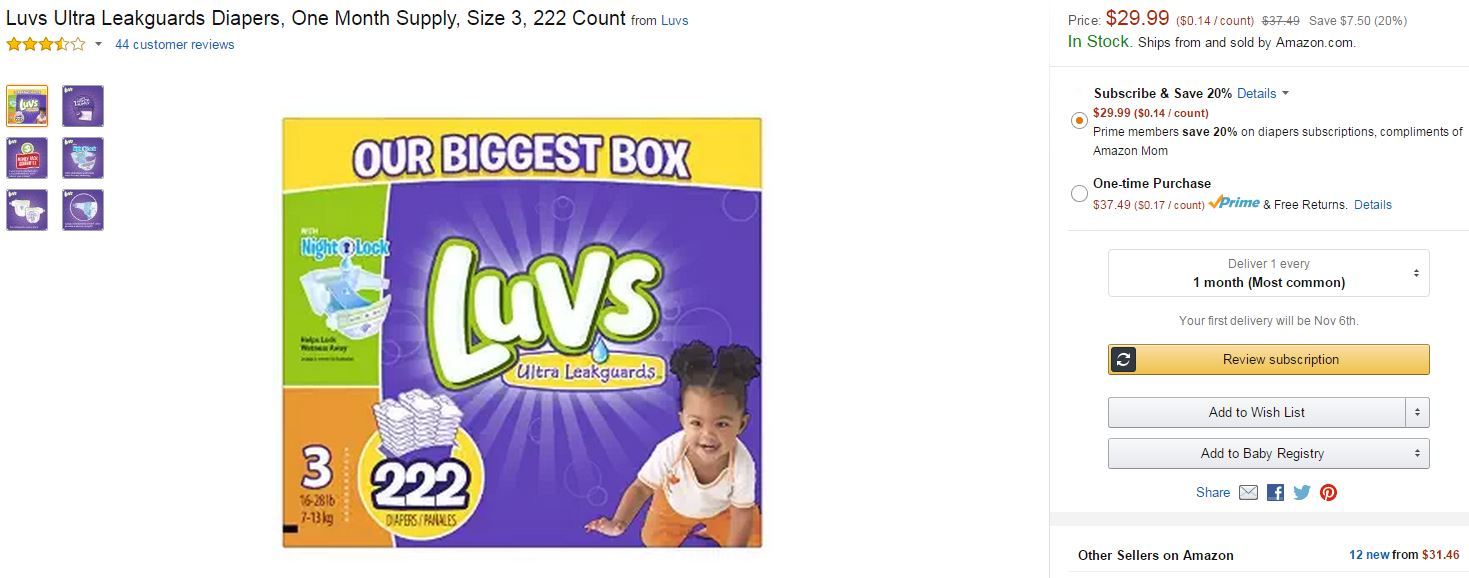
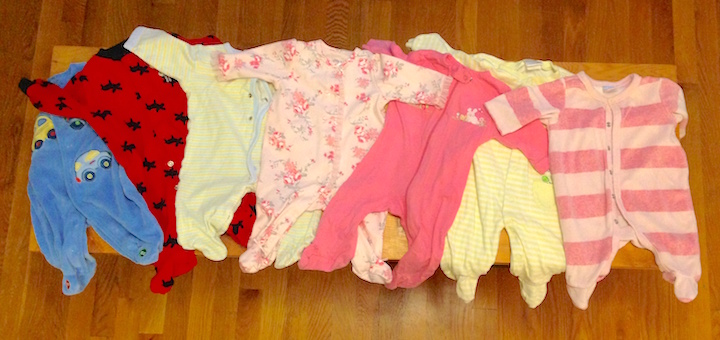
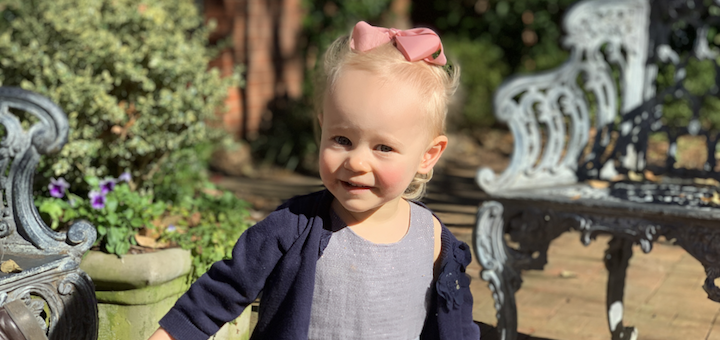
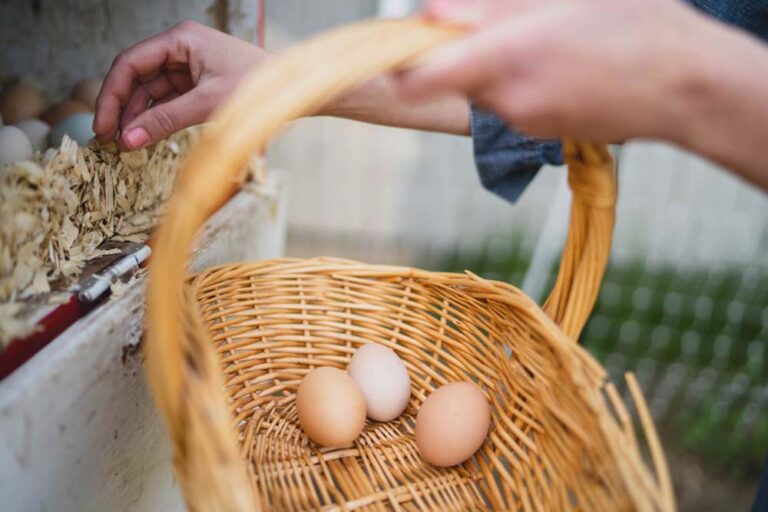
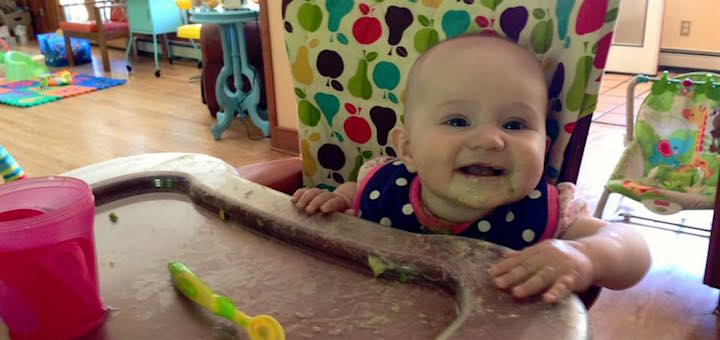
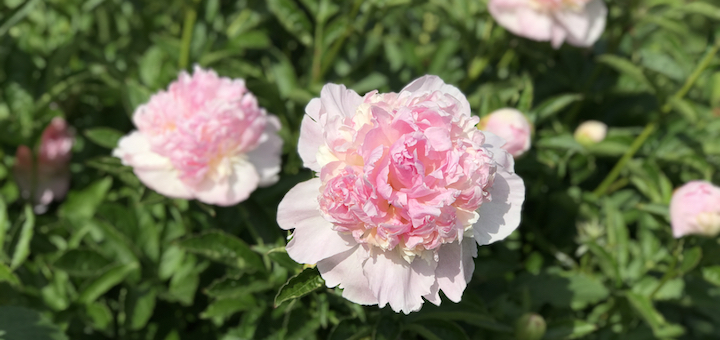
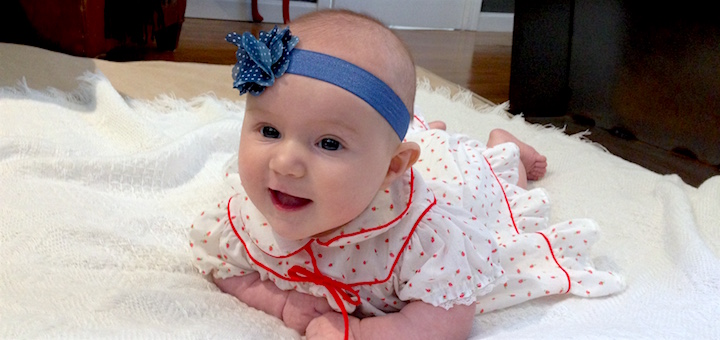
I had this very conversation with a close, pregnant friend the other day who is considering using cloth diapers. Interestingly, I lean towards disposables for this particular friend for reasons other than frugality. It’s been 6 years since I had my Mini Monster and I’m not sure I would automatically go for disposables now. I wasn’t a frugal weirdo 🙂 back then. If Mr. Mad Money Monster and I go for a second Mini, we will consider costs in every area. Butt 😉 I’m not sure we’ll leap into cloth based on the savings. The extreme hassle (in my mind) is a deterrent. If we opt for cloth, it’ll be to be green. The cost savings will be a side benefit. This is one area where my frugality needs some encouragement. Thanks for presenting this detailed account. I’ll be bookmarking this one!
Mrs. Mad Money Monster
It is certainly a personal choice and the savings might not be enough to entice everyone. Glad you found the info helpful!
When we let people know we’d be cloth diapering (to save money) EVERYONE told us what a hassle it would be. “My friend tried to do that. She only last two months before she said it was just too much and switched to disposables.” My husband was a bit horrified, but willing to try it for the savings. It helped that family members sent us their old cloth diapers so we’ve spent $0 to diaper her.
Anyway, don’t listen to the horror stories. Five months in my husband said, “I don’t know what all the fuss is about. This is not that hard. I think running out to buy diapers when we’re low would be way worse than running out to the garage and starting a load of laundry.” (And at the time, we were using a shared laundry facility with our upstairs neighbors.) After the Munchkin started solids it was a little bit worse, but not enough to deter us. In fact, we both feel that cloth diapering was one of the best decisions we made! To each their own, but you might discover that you don’t find it to be as horrendous as many people make it out to be.
+1 To all of this! This is exactly how it went for us. My husband was willing to try cloth once I brought it up because his mom cloth diapered all 5 of her kids, so it really wasn’t a big deal to him as long as I did the initial research (he did not want to look up poo stats but was more than willing to assist with dirty laundry doo-ty, ha! 😉 ) Since I was taking an extended leave from work, I chose flats (old-fashioned diapers) combined with the modern covers. Extremely easy to use if you pad fold, hard to ruin because you can bleach as needed (except for the covers). Since we can get very cheap disposables where we live, I began using one disposable at night and one for naptime (I didn’t think the diaper size was reasonable anymore after my baby hit 7 months, and it helped her to sleep much better at night).
At 18 months, we switched to disposables full-time, as our working/care situation has changed, but we still use the cloth wipes–those things are the gift that keeps on giving, and the carers prefer them because they’re thicker! You can wash them with anything–plain terrycloth–and we use them for cleaning up after meals, etc. without feeling that we’re wasting money. Our total spending on generic disposable diapers per month is 20 euros.
Wow! Thank you for taking the time to share all that good information! Thank you also for being so fair and non-judgmental. I know a few other moms who will appreciate this post, too, and I’ll share it with them.
I’d love the non-judgmental diaper info to become more widespread since it can be a confusing decision to navigate.
What a great article. I found myself laughing out loud while reading some of the descriptions of the daunting array of choices. I am thankful there were really only two choices when I had my babies – Pampers or cloth (the flat kind). I tried the Pampers and admit I used them for traveling but since none of my children were in day care and I was a stay-at-home mom, the choice was easy. I was an environmentalist waaay back in the 60’s. I had seven babies and started out with twins. The greatest gift to me was diaper service. With twins – well, the number of diapers was staggering but I used cloth and did not contribute to any landfill more than a hundred (I’m guessing) for all seven. Believe it, or not, I loved hanging diapers outside on the line. Winter was a bit of a challenge, but it can be done. As the babies became toddlers and pre-schoolers they’d laugh at the frozen diapers I’d bring in from the line. So, it’s what you make of it but I’m all for cloth diapers – Thanks for the great article!
You are a frugal diapering hero! With 7 kids I’m sure you saved a ton!
Kalie,
This is a great intro on the subject of frugal diapering! I did almost exactly the same thing as you, with a hybrid of cloth and disposables depending on the stage and situation. Savings balanced with Sanity.
I asked for cloth diapers at our baby shower since lots of other baby stuff we had gotten through other frugal means and didn’t need. I also put the word out among friends that if anyone had any they weren’t using I’d love to have them. I actually ended up with eight more this way once people knew. A lot of people otherwise thought I wouldn’t want “second hand” diapers. Who cares after a hot water cycle! Put the word out!
Great idea to just put the word out; barely used cloth diapers are pretty easy to come by!
When I worked at the day care of our local YMCA, we used to make our own wipes. It was so economical! I have quite a few friends who do cloth diapering and some who don’t. While I’d hate to speak out either way since I don’t have kids currently, I do think there are a variety of factors to consider – sanity, time, cost, and environmental. Really interesting post! I’ll be sharing with my mom-friends!
Finding the right wipes brand can be a bit tricky for babies with sensitive skin so homemade is great, thrifty solution. Glad you can share this!
In all due respect to your intelligent approach to this issue, Katie, I skimmed your piece and went right to the comments.
I was an ardent cloth diaper proponent when my first child was born. Disposables were only for an emergency and I think the supply I had came from a friend (I didn’t even buy them myself). I was a subscriber to Mothering magazine at the time (a periodical on radical motherhood, I used to call it). I was so ready to diaper the good old-fashioned way. But then…my son’s skin sensitivity to the “contents” of his diaper called the whole “project” to a halt. He was so hyper-sensitive that I was changing diapers – and doing wash constantly (‘tho I used a clothesline for drying). I tried every conceivable way of protecting his skin and had a pediatrician who was a supporter of my efforts. But in the end, for sake of my son’s red and sore backside, I had to go with disposables. There are many ways to “do the math” on this one; I’ve heard cloth and disposables defended convincingly from each side, but in the end it is your child that might swing the entire decision.
A child’s special needs is absolutely the determining factor in any parenting decision!
I worked full-time until my daughter was three so between not wanting to spend my limited time at home dealing with any more laundry and baby poop than necessary and not wanting to ask our childcare providers to deal with cloth diapers either, disposables were a clear choice for me. I did make sure to scout for the best price on disposables by bouncing between amazon.com and diapers.com; towards the end of my daughter’s diaper days I discovered that Aldi even sells diapers (love that store!), which were at a good price and worked fine.
I could definitely see working full-time as being a deterrent to cloth diapering. We have tried ALDI diapers with mixed results, but I’d say they compare with any other store brand. I love that store, too!
I worked full-time until my daughter was three so between not wanting to spend my limited time at home dealing with any more laundry and baby poop than necessary and not wanting to ask our childcare providers to deal with cloth diapers either, disposables were a clear choice for me. I did make sure to scout for the best price on disposables by bouncing between amazon.com and diapers.com; towards the end of my daughter’s diaper days I discovered that Aldi even sells diapers (love that store!), which were quite economical and worked fine.
Great article. I did a hybrid plan also. With my first, we used prefolded cloth and I washed them myself as well as made my own wipes. He was in daycare, but I found someone willing to use the cloth and just send them home with me to wash. Excellent! We used disposables when we traveled though. With my second, I admit, even though I was staying home, I used disposables probably more than cloth with her. I’m not sure if it was because I was overwhelmed with two little ones at home or if she was just more finicky and was never as happy in cloth or a combination of the two, but I didn’t use cloth nearly as much as with my first. Regardless, I’m super glad I used cloth as much as I did because the savings, especially combined with making my own wipes, which I never stopped doing, were huge. I saved the expense of buying any cloth diapers at all by simply asking for them at my baby shower.
I also found it harder to keep up with the second child in cloth, but I figured at that point, any time I used them I was saving since they had long since paid for themselves.
I just wanted to comment as a frugal person who has now been cloth diapering for the past almost 5 years (whoa, I’m not sure how it’s been almost 5 years!) that prefolds and flats don’t have to be complicated! I tried a mix of diapers with my first and settled on prefolds and covers. While I don’t mind folding and using a snappi (the rubber thing referenced above) it’s totally possible to just for the profiled in thirds and stuff it in a cover and slap it on a baby just like a disposable! My youngest is diapered pretty much exclusively like that! Double up for night time with two prefolds in there and you are golden. I do think a good cover makes a difference too, all but two of my Thirsties covers that we use are from my first kiddo and Flip covers also hold up really well despite being slightly more than some other options. I did get suckered into trying Alva diapers, which while they were cheap initially only lasted about 6 months before leaking, sometimes it’s worth it to spend more to get things to work long term! And even with it being a bit more, I’d estimate that we’ve spent no more than $800 to diaper all three kids and I should be able to resell what we have for at least $200 when we are done!
A really great site for info on refolds is http://www.greenmountaindiapers.com 🙂 thought I will admit I didn’t buy my refolds from them, mostly shopped sales (clothdiaper.com does a 12 days of Christmas sale each year where they have their sized refolds 40-60% off!)
Hopefully this comment might help others!
Very helpful info; thank you!
I’m going to agree with this, but go a step further! I have a huge time gap between my two daughters — my older daughter I had in 2002, and there weren’t that many options. I bought all my cloth diapers used on ebay, most from a diaper service. There were a handful of AIO’s in there, but I ended up cutting out the not very absorbant microfiber inserts and just using them as covers with prefolds, that I didn’t ever pin or snappy. From those years I learned that I like prefolds and covers more than AIOs, and that I definitely like snaps more than velcro.
Fast forward to 2016 when I’m having my second baby & need some diapers! I do all the reading a researching and decide that flats might actually be better than prefolds, because I read that they wash & dry quicker and more thoroughly. (They do! I love my flats & covers, and suspect that they’re not just more frugal, but also easier than pocket & AIO & even prefolded options!) Yeah… I can actually do an origami fold. I even did with my 6.5 lb baby when she was first born and everything was a little too big, because it allowed me to get a better fit than I ever could with an AIO or pocket. But in reality, I suspect most flat users just fold their flats into rectangles like I do most of the time. (But flats do have the versatility to be folded other ways for newborns or for potty training toddlers or for kids who wet heavier in the front or back or whatever. I like that…)
One cloth diapering trend that I don’t like in recent years is towards diapers & covers that supposedly fit from birth to potty-training. I don’t like the riser snaps as they seem to add bulkiness. One thing I love about thirsties is that they still make sized covers. (Sensible to me. It’s not like we expect any baby clothes to fit from birth to potty-training . . . ) They’ve got an outlet where you can get them at a discount, and really they’ll sell used for close to what you pay for them (especially if you buy used — you end up paying shipping). And they’ll last until the elastic goes after 15 kids or something even if your baby only wears them for a short time.
Websites . . .
https://www.thirstiesoutlet.com/
http://clothdiapertrader.com/
I’m getting married this year and I am excited to become a Dad sometime in the future, but I can’t say I’m excited for all aspects of parenthood… 🙂
Haha, good luck!
For anyone currently cloth diapering, I highly recommend fluff love university dot com for great information on wash routines and detergent.
If you buy high quality diapers secondhand and then resell them, you might even break even on the costs, making laundry your only expense.
Great recommendations! I completely agree that if you’re able to sell them, your costs will be minimal.
We used disposables, mostly because laundry facilities were not terribly convenient. I found store brands to be the cheapest. CVS brand conbined with extra buck deals sometimes resulted in diapers less than $.07-.08. Target diapers on sale are also a good deal–usually twelve cents or so, depending on the size.
Great tips for store brands; thanks for sharing!
Funny story- I don’t judge a parent either way, both seem to have their high points. While at the work company party this year at the local country club, the mere mention of cloth v.s. disposable caused her to whip out and open up a cloth diaper and explain the ease of cleaning them in the infant/breastfeeding months. Mind you it was at the dinner table during the risotto course. I don’t have kids yet but the jury is still out.
That is a funny story, and certainly illustrates my point about how hot of a debate this can be. It probably doesn’t need to be so intense, huh?
Anyone have any experience using cloth for overnight pull-ups? One of my boys is in the 40-60 lb range and uses a disposable each night. Not sure how common cloth is for a situation like this, but I figured there’s got to be someone doing it!
They do make cloth pull ups. Look at diaperjunction.com. I believe they sell them for that weight range.
Thanks for the recommendation. I think I found something that I’m going to try!
Another option for overnight is two pairs of cloth trainers–like the old Gerber ones–under a rubber cover. But… I use Pull-Ups at night. I had too many leaks and Little Brother (now 3 1/2) still likes to wake himself up with a good poop.
I love my cloth diapers. We bought the inexpensive ones (24 diapers and 48 insersts for $125) before our daughter was born and they’re still going strong with our second child 5 years later. I also pick up used ones from friends or cloth diapering groups on Facebook when I need to replace one. There’s no question that we save money by using cloth. I highly recommend getting the diaper sprayer attachment (or building one yourself) for the toilet. It makes clean up and laundry way easier.
yeah, I’ve heard about better, leak-resistant brands for diaper sprayers. For people who have problems with diaper sprayers, be sure the attachments aren’t made of plastic–those can crack and leak. Look for sprayers with all metal fixtures to avoid flooding.
The sprayer definitely makes the clean up job easier!
I’m surprised you don’t mention Green Mountain Diapers–although they sell, they are super helpful on information, folding styles, etc. Also, a quick youtube search of cloth diapering leads to so much helpful information on folding styles, etc.
We’re going to try pre-fold cloth diapers with cheap covers. I’ve seen them used even without snappies or pins, tucked into a cover sort of like a traditional diaper. But also, the fold method does depend on the wee one’s bodily functions so you have to adjust as necessary. My mom says the “jelly roll” fold would have been appropriate for me as a baby as I was prone to “blow-outs”, so you gotta try different folds to see what works. Like you say, we’ll probably get a few all-in-one’s when the kid is with other family members for convenience. Also, we will have a stay-at-home granny (mi madre) who will take care of the kid and she’s ok with cloth diapering. Not everyone has that luxury and may have to use disposables.
I actually hear cloth diapers #1 compliment is that they can greatly reduce diaper rash. The only exception to that issue can be at night, when a “stay-dri” liner might be necessary to help keep urine away from the baby’s bum, especially if the baby tends to sleep through soaked diapers. but something about the breathability of cloth helps keep the bum mostly free of irritation, at least from the multitude of stories I’ve read online. Although, I don’t think any scientific studies have proved this, lol. I’ve also heard that cloth diapers can make the transition to potty training easier since kids feel the wetness and poop more severely than in disposable diapers, so they are more aware of their bodily functions (again, not scientifically proven). But like my mom says about potty training, I had so many stomach problems as a baby that potty training me was a nightmare, so even if I was in cloth (I wasn’t), I doubt we could have transitioned early!
But like you say, EVERY baby is different so do what works! We will try to do cloth as long as possible. If it doesn’t work, we’ll switch to disposable.
Green Mountain Diapers is a great site. Thanks for mentioning it. There are just so many resources out there!
Yes, it’s hard to objectively answer about the diaper rash perk, but it’s a good possibility that cloth diapers will reduce it. Best wishes for your cloth diapering and motherhood journey!
I ended up using a hybrid of cloth/disposable on my first child and then mostly disposable on my second. On the lines of every child is different, my experience was that cloth diapers actually caused more rashes than disposables (mainly the non-wicking ability to get the wetness of the urine away from the skin) , especially on my second child. Similar to Allie’s experience this ended up being the reason for more disposables with my second. I also found around the time my first turned three we had a really difficult time with leakage from cloth diapers (and we tried different kinds and sizes!)…up to that point we had been pretty exclusively cloth but that’s when disposables started to make their case.
In terms of laundry, costs aside a good sunbath did wonders for smell. By the time my second child was in disposables I could swear there was always a little scent of urine around unless the diapers had a good sun soak. Can’t beat good old Mother Nature!
The sun does wonders for cloth diapers! It does seem like modern disposables wick moisture away quite well.
So interesting! Way back in the day, when I was a wee dinosaur, only the oragami triangle and large duck pins were available.
There were 3 of us under age 2, so we would have to include the price of wine for mum.
Breastfeeding was gauche and only for the medieval poor in those days.
I do remember being changed and always worried about that scary duck pin sticking me. The plastic pants hurt and chafed my legs.
I was always sickly but my siblings not.
We may have had disposables for camping- as a preemie, mum had to buy doll diapers and doll clothes.
I love the careful analysis and payout dates done-very well-written!
Think I will reblog this gem 🙂
The cloth diaper scene sure has changed. I think the problems you experienced are some of the reasons for innovations like all-in-ones and snappi fasteners.
A comment from Mr. Wannabe:
With cloth diapers, any concern over e coli? I think I recall the smell of ammonia but who knows if that was for the diapers.
Did anyone get sick?
I never had a problem, though I would switch to disposables during a stomach illness for ease and sanitation. A vinegar rinse can help with the ammonia smell.
So I work under universal precautions: treating all materials at work, including our clothes, as “hot”/highly contagious fomites. Last time I looked, laundering to “hygienically clean” (the CDC designation below “sterile”) was a cycle run with detergent in >160 deg. F water for at least 25 minutes. This requires a detergent formulated for hot washes; most consumer-grade ones will start to degrade at temperatures that high.
I know my shared laundry setup can’t do that–and many household water heaters/furnaces have a lower temperature cap to prevent the water from ever getting hot enough in faucets to scald people–so transmission of E. coli and boatloads of other germs is definitely possible. Of course, the regulation is the catchall. Some germs will deactivate at lower temperatures and won’t last long even in the laundry bin, then there are things like hepatitis B that stay contagious in a dried blood spot for a week.
Which is one of many reasons why we are leaning towards disposables for the baby-to-be. I know most people using the laundry machines have no second thoughts about transmission, but personally I just can’t feel OK about potentially exposing other kids with immunity issues in the building to whatever the kiddo is carrying. *shrug*
Meandering back on topic, it’s good to see some solid numbers associated with all the options. For pay laundry, $1.50 per small load wash and $1.50 for a dry cycle that leaves everything slightly moist doesn’t help the cloth numbers.
Thanks for sharing this information, Jana. I agree shared laundry costs could easily eat your savings.
When I had my first and worked on & off I strictly used disposables. And I had several friends that did cloth and I couldn’t understand why! Now, I have twin 15mo and have clothed since they were about 3 months. I switched bc of the $ and bc it was killing me to empty that big bag of disposables every couple of days. And of course none of my friends here (moved too) don’t cloth. I am one of those that learned her lesson in many ways lol! Also it took me a while to figure out what worked for me and my twins, as one of them has very sensitive skin, but now it’s working well. I also do a hybrid- cloth by day and disposable by night, and living in Texas we use disposable in the really hot months as they get heat rashes otherwise. It’s not perfect but it works for us and I know I’m doing what I can as a now sahm to save both $ and the environment. I’ll take the rewards where I can get them lol!
I know for me, being a SAHM gave me the time and motivation to save money using cloth. It may have been a different story if I was working FT outside the home.
You can also sell the cloth diapers after you have had all the babies you want, and likely recoup around 50% of your initial investment, at least here in the UK.
On this note, consider buying used cloth diapers, some might have a few stains, but they will be perfectly usable! If squeamish about stains, just give them a goid bleaching before using on your baby!
Yes, I did not factor in the benefits of reselling but it’s a great option.
Well I’m expecting my second child in late February, and I did cloth diaper my first while holding a full time job. Still working full time now and I never found it to be a hassle. It was like having one extra load of clothes to do every other day. Once you get in a routine it is super easy. Also, diapers including disposables should be emptied into the toilet anyways, so might as well be using a cloth diaper.
I was also surprised to find the chain daycare centers (including Kids R Kids and Kindercare) in Houston, Texas very accepting of cloth diapers. They both allowed me to use them. This was recently too. My son has finally outgrown his cloth diapers and now we are using disposables and currently potty training.
I think for me the hardest part was working through all of the information that is available on the internet regarding cloth diapers. My only tip is to use all-in-ones with velcro for daycare since it is the easiest for them to handle. If you want to convince a daycare to use your diapers, make it as easy as possible.
Thanks for weighing in from the FT working mom perspective. I agree that establishing a washing routine made it pretty easy for me. As a mom, you’re going to be doing a lot of laundry anyway. Great tips for daycare-friendly diapers, too.
I’ve always liked the idea of cloth diapering (I don’t have any kids) for environmental and frugality reasons. Thanks for this detailed post! I appreciate your non-dogmatic approach.
However, I recently moved to an apartment in Seattle and started thinking about how our new living situation might change the equation when we do have our first child. We share 1 washer and 1 dryer with 5 other units in our building. With so few hours of sunshine each week, I’m not too optimistic about sun-drying, either, even if we could put up a line, which I think we can’t.
I’ll try to re-run your numbers with a flat $2/load plus detergent laundry cost. How many cloth diapers do you wash in one load? And do you have any thoughts about the feasibility of cloth diapering in this situation? I tried to ask Google about it a while ago and stumbled on an intense debate over the ethics of washing diapers in a shared machine!
My loads of about 20 diapers were on the small setting–you’re probably not going to buy more than you can wash in one load. From a purely logical point of view, I don’t think washing in shared laundry is actually wrong. I mean, you wouldn’t wash them in your home machine if you thought you were going to have poop all over your other clothing in normal loads. However, I could see not wanting to risk controversy, seeming inconsiderate, or dealing with a messy machine malfunction. You can easily line-dry them inside if you have a little space for a line or rack. I hope this helps!
Cloth diaper is great, that’s what we used for Baby T and will be using that for the upcoming baby too. The sprayer is a highly recommended tool if you go with cloth diaper.
The sprayer definitely makes clean-up easier.
For the truly frugal! Apparently children of the Digo tribe are toilet trained by 5 or 6 months, rendering the previous discussion largely moot.
Ideas about infant capabilities and toilet training practice have changed in the United States following cultural trends and the advice of child care experts. Anthropologists have shown that a society’s specific infant training practices are adaptive to survival and cultural values. The different expectations of infant behavior of the East African Digo produces a markedly different toilet training approach than the current maturational readiness method recommended in America. The Digo believe that infants can learn soon after birth and begin motor and toilet training in the first weeks of life. With a nurturant conditioning approach, night and day dryness is accomplished by 5 or 6 months. The success of early Digo training suggests that sociocultural factors are more important determinants of toilet training readiness than is currently thought.
http://www.ncbi.nlm.nih.gov/pubmed/887331
There are so many assumptions about child care that are cultural. Thanks for sharing!
Sounds like we did it a lot the same. I do the folding thing, but it’s no biggie. What a great and informative article for someone who’s considering cloth but not ready to take the plunge. I think most people are just plain intimidated for no reason. I’m inspired to try the cloth wipes now too!! You make it sound so easy, and we’ve been buying wipes for going on three years! Do you keep a little container of water at the changing table or soak them, or run to the faucet?
We ran to the faucet, but I know people who keep pitchers of wipes solution or soak them in old wipes containers.
We’re considering cloth for baby #2. I’ve already got several months worth of disposables that I purchased on a mega-deal, so I have a few more months to decide.
We bought a few covers for swimming diapers and have never regretted that decision 🙂
It’s nice you have a buffer to decide as you adjust to a family of four.
I had two in cloth diapers at once, which I believe qualifies me for a medal of some kind.
My tips:
1. Don’t overpurchase.There are any number of gadgets and geegaws you can buy for cloth diapering, almost all of which you do not need.
2. Store brand diapers FTW. They will feel magical compared to cloth when you do need disposables.
3. Overnight: Hemp is your friend. Many people wuss out and use disposable overnight. Maybe not necessary. Try this: One microfiber insert, one hemp insert, inside a pocket diaper. Cover the whole thing with pull-on plastic Gerber-type pants.
I’d grant a medal for that! Good to know about hemp inserts for overnight.
I’d prefer cloth diapering because it can save lots of money and environment friendly. I don’t have baby yet, but I hope I can wash cloth diapers
I think with those motivations you can do it!
I think this was a great article! However, just want to point out. We use Target’s Up & Up diapers, which they frequently have on sales and sometimes sale with gift card. When we do those together and stock up (which is the only way we buy) then the price is usually more like .09 per diaper instead of .15 particularly if you have red card. If you plan ahead and purchase well (and not too much!) getting .09/.1 per diaper is definitely possible. Cloth is likely still cheaper, but this really cuts the savings down. We have had no issues with these diapers, used them for two kids.
Great tip. So many areas of frugality just require a little planning ahead.
I used pocket diapers (stuffed with prefolds) for my son. I personally loved it. We did use disposables when he was a newborn as well as traveling. Otherwise it just became a part of our daily rhythm. I miss seeing the little cloth fluffy bum. You do need to take into account pant sizes with babies as cloth takes up more space. A great site for inexpensive cute cloth pocket diapers is http://www.alvababy.com/
I agree the cloth diaper bums are adorable!
There’s a third option to add to this list! Elimination Communication can be used full time or part time to reduce the number of diapers you use. We do it part time, when it’s convenient, and always use a diaper as a backup. We just put the baby on the toilet when he wakes up, after he eats, when he obviously needs to go (lots of babys are obvious poopers), or when we’re changing his diaper anyway. Fewer diapers soiled per day and the baby gets acquainted with the toilet early so potty training *could* be easier/earlier. My daughter was out of diapers full time at 18 months and my 13 month old is already telling me when he has to poop so I can help him get on the toilet. I’m a stay at home mom, so it’s easier than if I were working, but it’s really not as much work as people seem to think it is – if the diaper is off for a diaper change anyway, see if they need to empty their bladder so that next diaper stays dry longer!
Thanks for covering this. We tried EC with our babies but they really hated being on the potty. But I have a friend who has had great success with this approach. It is definitely worth a try and reduces the number of diapers you go through.
Glad to hear you mention this. We had good success (initially) with elimination communication as well, it surprised me because I was skeptical, as the idea that babies have to be in diapers is so prevalent in the West. After a couple people mentioned it, we tried it, and our son took to it, it was most obvious when he was four months old, we were travelling, and had used disposables on the trip so that we wouldn’t have to wash diapers, but every now and then he would fuss and hold it in until we held him in position over a toilet and he could do his business. I was pretty surprised!
Unfortunately, he fell out of practice once we started daycare (they didn’t have the time), but at least daycare was very accomdating about cloth diapers. They said we were the first to ever ask, but were willing to give it a try and were happy to try and do their bit for the environment.
Thanks for showing a hybrid approach! I work full time and cloth diaper my 10 month old when he’s with me, but send disposables to daycare. I find it great not to worry about buying / ordering diapers on a regular basis. I always have enough. I started with a variety, and I’ve been surprised with how much I like the old fashioned prefolds and flats. I padfold them now, and they’re easy to deal with in the laundry. A year ago I would have told you that all-in-ones sound great, but the simplicity of plain cotton diapers is hard to beat for me
Sounds like you’ve found a great approach!
We use cloth diapers & they really aren’t that bad & get cheaper with each additional child. We did use newborn disposables for the first week or so for convenience & when we travel. We bought a couple different brands to see what we liked most & recommend Bum Genius or Ragababes, but the good ol’ prefold insert is nice too. Each brand has their pros & cons but you get what you pay for.
We wash our own diapers, and I recommend using an old school machine with an agitator. The high-efficiency machines are lacking. Also dry them in the sun as much as possible. It will extend the diaper life and bleach them brighter.
I didn’t know that about HE washers; we have an old school one which worked great.
We did something very similar to Kaylie. I used disposables when they were newborns. I discovered there is something in proctor and gamble diapers that gave both my children horrific rashes so we used Huggies. It seems P&G must manufacture the store brands we tried as well so they were not an option for us.
Once my daughters fit in non-newborn sized diapers, we made the switch to cloth. I used all in ones and found that if I shoved two inserts in there (three as she got older), we could make it through the night with no leaks. I have a washer and one of those accordion style drying racks right in my house so doing laundry was easy for me – I realize it can be a giant hassle if you do not have this luxury. Cloth took us all the way to potty training but both my children are smallish and quite thin so I never had to invest in larger cloth diapers. By the time medium cloth diapers were getting small on them, I potty trained (18 months and 21 months). I never bought training pants. We bought thin undies at target, turned up the heat, and had the girls wear those with no pants. Pee running down your leg is a good motivator! Needless to say, we did not go many places for a few weeks (with child two – child one was one of those ridiculously easy types who potty trained in two days at 18 months; child two was more complicated).
If cloth is not for you, feel free to ignore this post. There is no one best answer here, or in most things having to with parenting. We all muddle through. We all screw up. Children are pretty resilient and diapers are a non-issue in the grand scheme of things.
I agree that diapers are not going to make or break your parenting, and hope this post can ease some of the tension expecting parents often feel over the issue.
I was wondering if anyone commenting has experience cloth diapering while having to use coin operated laundry facilities (apartment building, not in unit). I feel like this might ruin the savings of cloth :-/. I was contemplating a diaper service instead, but it seems like that isn’t really financially better.
I don’t have experience with coin-operating diaper laundering, but I imagine it’s much less economical, and might not go over well with other residents. Historically people have washed diapers by hand at the end of each day, but that could be a bit much for our modern sensibilities.
My grandmother had her first two babies 10 months apart while living in a one room apartment with no private bathroom. There was a shared bathroom on each floor of the apartment building. This was in the 1940s, so disposables were not an option. She washed the diapers by hand in the kitchenette sink and hung them to dry around the apartment.
If I could go back in time and bring her some Pampers, I totally would.
We used cloth diapers for our 2 kids, at home. Out and about, disposables were more convenient. I liked the big traditional mthin ultifold diapers with diaper pins. They dried much quicker.
BTW, diapers make fine lint-free wipes after the kids are potty trained, for windows, for polishing, ….
Great tip for re-purposing the diapers later!
I really like your non-judgemental approach, Kalie. 🙂
This is just one of those areas I – somewhat sheepishly – chose convenience over frugality. I was actually more swayed toward cloth diapering by the environmental benefits, but ultimately, I just couldn’t get past the shaking poop out of the diapers and washing them. Also my husband NEVER would’ve gone along with cloth diapers. I used coupons and bought our disposables wherever I could get the best price, usually BJ’s or Target.
Luckily diapering doesn’t last forever so there’s a limit on the price of diapering.
A few things I have learned about diapering:
-Unless you plan for 2+ kids newborn cloth is not really worth it, I wish I had just used disposable.
-Cloth really just amounts to a couple of extra loads of laundry a week. You’re doing so much anyway who cares about a couple of extra loads?
-Country Save detergent, available on Amazon is great for cloth diapers, quite economical and works well.
-My best discovery of all is that disposable wipes can be laundered and reused (some brands better than others). In addition to reusing them as wipes I also lined all my diapers with them so that you can just peel off the poo and swish the wipe in the toilet to get rid of the poo.
-Wipe solution:
2 cups boiled or distilled water
2 tbsp oil
2 tbsp liquid soap
-I used disposables for outings, always.
-Costco disposables are excellent. I have left them on my son an embarrassingly long time without a hint of rash or leaks.
Great tips! My newborns were too small for the cloth ones I purchased so I used disposables for a bit. I completely agree with your assessment of the laundry situation. With kids you’re already in the business of lots of laundry; I barely noticed doing a little extra. I accidentally washed disposable wipes and then started reusing them too. I wish I would’ve thought to use them as diapers liners like you did, though!
You can also buy dry wipes that are diaper liners for cloth diapers. Super useful.
We cloth diapered The Boy, who is now almost 8, and were pretty happy with it. We even convinced our day care to accept it, as I was working full time then. We had some pocket diapers and some old fashioned prefolds with Thirsties covers. We ended up finding the old prefolds were the easiest to clean and wash, and never did any fancy folding with them- we just used a Snappi. The only time we used disposables with him was when it came to potty training and he used a pull-up. With our two girls, we wanted to use the same cloth, but they each had constant yeast issues, and would have bleeding open sores. It was awful! They just couldn’t take even a little dampness, though I know plenty of girls (including me) that did fine with cloth. We buy Target diapers now. We frequently get gift cards for birthday and Christmas gifts, and I buy huge packs when I can get a $15 gift card when you buy two. My in-laws will also buy diaper packs as gifts. Doing this, I probably have paid $150 out of pocket per year for diapers, and I keep rolling those gift cards. I sold most of my cloth stash to a friend, and we use our cloth wipes and the sad looking prefolds as rags.
Sorry to hear your girls had such problems! But that’s great you found a frugal solution that worked for them.
We couldn’t do cloth due to daycare (tho we have used it on occasion at home because I got a few at my shower). But we use and love cloth wipes! We use them only for urine, but it is amazing how much longer wipes last when you only use them for poo. I just throw the cloth wipes in with our normal wash (with towels), so it doesn’t add anything to doing loads. In terms of wetting the clothes, I keep a little spray bottle next to the diaper station. I spray the wipe a few times on one corner, wipe off, and then use a dry corner to pat dry. Super easy.
We do use Earth’s best dipes for a variety of reasons. I’ve found diapers.com or target subscribe and save are our best options. Sales come around 1-2x per year on diapers.com for all sorts of diapers.
Great idea with the spray bottle!
Cloth isn’t a great option for our family, but I just wanted to point out there are much cheaper options for disposables out there that make the comparison above seem somewhat slated. We use target’s up and up diapers and I stock up at sales. Most recently I bought size 4 diapers for 10 cents each (smaller sizes were even less per diaper). We spend approx $20/month on diapers (varied as the baby moves through sizes), and this isn’t with a tremendous amount of effort–I just check the target ad and stock up at good prices.
While I did price-check Target’s normal prices, I believe that stocking up on sales could yield better prices. Target diapers seems like a popular, inexpensive option.
I cloth diapered both my children and although my main motivation was initially environmentally-based, I eventually found I just really preferred cloth diapers over disposable. Think of it as using ‘real’ kitchen-ware vs. paper plates, styrofoam cups and plastic utensils every day. The disposable stuff has its place (I used disposable diapers when we were traveling or out all day), but it’s just nicer to use the real thing.
Good post.
My frugal tip for cloth diapering for those fortunate enough to receive lots of new baby gifts:
Register for cloth diapers! But here’s the real tip, because you may or may not get much from your registry. If you still need more cloth diapers, leave the tags on a bunch of other extra items you don’t need but may receive as well meaning gifts (e.g. newborn size summer rompers for a baby due in November…) then return all of the unneeded items and use the store credit for diapers! We got six Bum Genius all-in-ones for “free” this way! We do a mix of all-in-ones for our childcare (my wonderful in-laws, want to make life easier for them) and prefolds/covers at home.
I’ve also noticed waaaaay fewer blow-outs with cloth diapers. We use disposables from Aldi sometimes as well–they seem to work as well as other brands we’ve tried, and they can be as cheap as $0.10/diaper in the smallest sizes! :O
I love this blog in general, but felt this post–while INCREDIBLY organized, well laid out)–leaves out a common scenario for the legions of us urban dwellers who have to pay for laundry by the load. Where is that analysis?
For example, in my apartment building, laundry is $2.00 per wash and $2.50 dry cycle and we don’t have anywhere to line dry, so that’s an extra $4.50 per use of 24 diapers — aka… 19 cents per bowel movement. (because i’m guessing you don’t wash poopy diapers with anything else, yes?)
Maybe you could amend and add a section in for the frugal city folk. I promise, there are a lot of us!
I have 3 kids. I cloth diapered my first and second kid along with some supplemental disposables. Kid #3 was in cloth from right after birth until potty training. It was super easy to do all cloth and not a big deal at all. For the newborn stage, I used lots of prefolds and covers. As she got older, I used some of the outgrown cloth diapers from her siblings. After she was done with them, I donated some to an African charity and some to a friend who lost her job right after adopting a baby.
To me, running to the store because of running out of disposables and constantly having to buy more of them seems like too much expense and hassle. But we do have our own washer and dryer and also have a diaper sprayer in our bathroom. Paying for laundry on a regular basis would change the equation.
We have a newly adopted 14 year old daughter whom we are using the cloth pin on diapers on with the rubberpants over them,24/7 due to her daytime accidents and bedwetting some.I was lucky to find some of her diapers and rubberpants at a garage sale just before we got her,then added new cloth diapers we got from websites.Her rubberpants are all adult size and in pastels and prints and so far she has had no issues wearing them.
Diapered all 3 from day one through potty and one through bedwetting to age 11.